Overview
Muscles get stronger when they are used regularly, but especially when they have to work against something. This is called "resistance."
For example, you use your arm muscles when you bend your arm at the elbow. But when you do the same movement with something heavy in your hand, your arm muscles are working against more resistance.
"Resistance training" means using things like weights, rubber tubing, or certain exercises to make your muscles stronger. It's a 3-step process:
- Step 1: Stress.
-
When you exercise against resistance, you stress your muscles slightly but not to the point of serious damage or injury.
- Step 2: Recovery (rest).
-
When you rest, your body rebuilds the muscles and the connective tissues between them (joints, tendons, and ligaments). This prepares them for the next time they will be stressed.
- Step 3: Repeated stress.
-
When you stress the same muscles again, the process is repeated. The muscles get stronger over time.
A resistance-training program to increase muscle fitness can include:
- Basic muscle-conditioning exercises such as push-ups, leg lifts, and other common exercises.
- Resistance training with exercise bands.
- Weight training with free weights ("dumbbells") or weight-training equipment.
- Doing heavy housework and yard work on a regular basis. This may include scrubbing the bathtub, washing walls, tilling the garden, or pulling weeds.
- Strengthening the muscles of your trunk (core). This helps you have better posture and balance. It can help protect you from injury.
Benefits of strength training
Strength training has many benefits, including:
- Stronger muscles, which help protect your joints.
- Less body fat.
- Stronger bones.
- Better posture and balance.
- Lower blood sugar.
- Less stress.
- Fewer body aches.
- More energy.
Stronger muscles can work longer before they get tired. Many daily activities require you to move, lift, or control a weight. Muscle strength will help you do these activities with less stress on your muscles. You'll notice that you can lift heavy grocery bags more easily. You can pick up children without feeling as much strain. And you can carry heavy items longer before you get tired.
Doing the right amount of strength training
Experts say it's best to do exercises to strengthen bones and muscles at least 2 times each week.footnote 1 For example, you could do weight training or stair climbing.
How many repetitions and sets you do of a specific exercise depends on your goals.
- Repetitions are the number of times you continuously perform each exercise. For example, if you lift a dumbbell up and down once, that's 1 repetition (or rep). If you lift it 5 times, that's 5 reps.
- Sets are the number of times you do a certain number of repetitions. For example, if you lift the dumbbell 15 times, take a rest, and then lift it another 15 times, you have done 2 sets of 15 reps each.
If your goal is to gain strength, do a few sets of a few reps with heavy weights. If you want to increase muscle tone and endurance, do a few sets of many reps with light or medium weights.
One way is to use a weight that makes your muscles tired after 8 to 12 repetitions of each exercise. As you build muscle strength, you'll notice that you can do more and more of each exercise. Some people will see a change in the way their muscles look. But other people won't see a change for a long time. A more important sign of progress is how many repetitions and sets of an exercise you can do, or how much easier it feels to do them. This means that your muscle fitness has improved.
Building your muscle fitness safely
Strength training is an important part of overall physical fitness. Here's how to build your muscle fitness safely.
- If you can, learn from a professional.
Your training can be from a local YMCA, a fitness club, or an experienced professional trainer. Set a goal such as body building, toning and shaping certain body areas, or improving performance in a certain sport.
- Don't forget to warm up.
Take 5 to 10 minutes to walk or jog in place.
- Learn the proper form for each exercise, and then always use it.
The proper form ensures that you get the most out of each exercise. It also helps prevent injuries. A good trainer will teach you about proper form.
- Give your body time to adjust.
Allow at least 2 weeks for your muscles and connective tissues to adjust to the new stresses and strains of weight training. Start by lifting weights that are lighter than you can manage. This helps you tell the difference between the normal aches and pains of weight training and the pains of overuse or real damage.
- Work slowly, and move your muscles through their full range of motion.
Do fewer repetitions slowly, using the entire length of the muscle. This works better than doing many repetitions quickly with only a short part of the muscle.
- Learn how to breathe properly when you work with weights.
Exhale when you push against the weight. Don't hold your breath at any point. Inhale when there is little or no resistance.
- If you can, ask a trainer for help.
If you are starting weight training on your own, here is a basic plan you could follow.
- Start with 2 to 3 sets of 8 to 12 repetitions. Start with a weight that's hard to lift on the 8th repetition.
- Increase the weight you lift when you can do 12 repetitions. With the increased weight, you might have to go back to 8 repetitions. When you can do 12 repetitions with the increased weight, try adding a little more weight.
- Vary your program.
Variety keeps your interest up and injuries down. Mix muscle strengthening with flexibility and aerobic work. Also, vary your work by switching between:
- Your upper body and lower body.
- Free weights (barbells) and machines.
- Heavier weights with fewer repetitions and lighter weights with more repetitions.
By starting slowly and using the right technique, you may find that weight training is an enjoyable and effective way to build strength.
Health Tools
Health Tools help you make wise health decisions or take action to improve your health.
Exercises
Basic muscle conditioning
Wall push-up
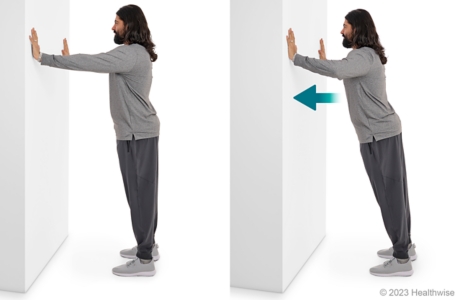
- Stand facing a wall with your feet about 12 to 24 inches from the wall. If you feel any pain when you do this exercise, stand closer to the wall.
- Place your hands on the wall at shoulder height, slightly wider apart than your shoulders. Turn your fingers out a little, rather than straight up and down.
- Slowly bend your elbows and bring your face toward the wall, keeping your shoulders and hips lined up. Then slowly push back to the starting position. Keep the motion smooth and controlled.
- Repeat 8 to 12 times.
When you can do this exercise against a wall with ease and no pain, you can try it against a counter. You can then slowly progress to the end of a couch, then to a sturdy chair, and finally to the floor.
Quadriceps (thigh) strengthening
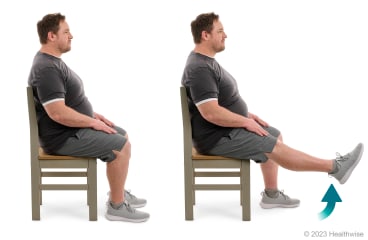
- While sitting in a chair, straighten one leg and hold for 6 seconds. Do not lock your knee. Then slowly lower your leg.
- Repeat 8 to 12 times with each leg.
When this exercise becomes easy, you can add a light weight to your ankle.
Hip abduction (lying on side)
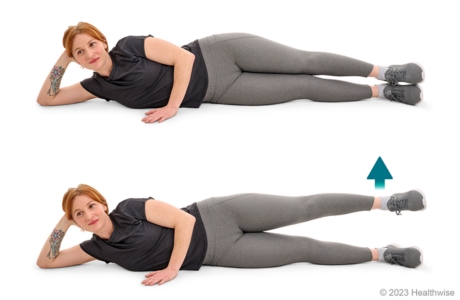
- Lie on your side, with your affected leg on top. You can use your hand or a pillow to support your head.
- Keep your knee straight and your leg in a straight line with your body.
- Lift your affected leg straight up toward the ceiling, about 12 inches off the floor. Hold for about 6 seconds, then slowly lower your leg.
- Repeat 8 to 12 times.
- It's a good idea to repeat these steps on your other side.
- Keep your kneecap pointing forward.
- Don't let your hip drop back.
Shallow standing knee bend
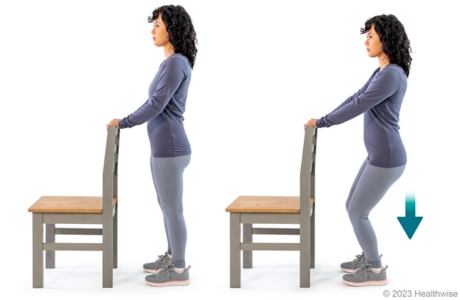
- Stand with your hands lightly resting on a counter or chair in front of you. Put your feet shoulder-width apart.
- Slowly bend your knees so that you squat down like you're going to sit in a chair. Make sure that your knees don't go in front of your toes.
- Lower yourself about 6 inches. Your heels should stay on the floor at all times.
- Rise slowly to a standing position.
- Repeat 8 to 12 times.
Resistance training with exercise bands
Side pull
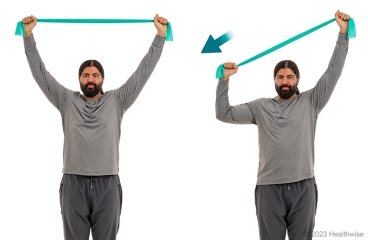
- Sit or stand up straight. Grasp an exercise band with your hands about shoulder-width apart.
- Raise both arms overhead, palms of your hands facing forward.
- Slowly pull one arm down and to the side, bending your elbow and stretching the band until your elbow is at shoulder height. Hold for 1 to 2 seconds.
- Slowly return to the starting position with your arms straight up.
- Repeat with the other arm.
- Repeat 8 to 12 times with each arm.
Overhead pull
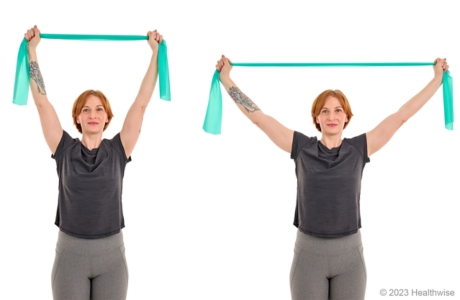
- Sit or stand up straight. Grasp an exercise band with your hands about shoulder-width apart.
- Raise both arms overhead, palms of your hands facing forward.
- Slowly pull your hands apart, stretching the band. Hold for 1 to 2 seconds.
- Slowly return to the starting position with your arms straight up.
- Repeat 8 to 12 times.
Up-down pull
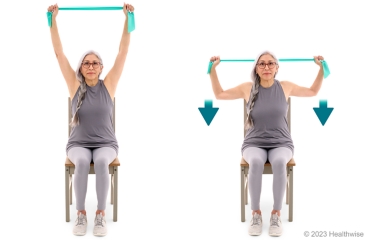
- Sit or stand up straight. Grasp an exercise band with your hands about shoulder width apart.
- Raise both arms overhead.
- Bend your elbows until they are at shoulder height, with the stretched band either behind or in front of your head. Hold for 1 to 2 seconds.
- Slowly return to the starting position with your arms straight up.
- Repeat 8 to 12 times.
Chest-level pull

- Sit or stand up straight. Grasp an exercise band with your hands about shoulder-width apart.
- Raise your arms to chest level and bend your elbows.
- Slowly pull your hands apart and your shoulder blades together, stretching the band. Hold for 1 to 2 seconds. Try to keep your hands up at your chest level, and do not pull your shoulders up toward your ears.
- Slowly return to your starting position.
- Repeat 8 to 12 times.
Hip-level pull
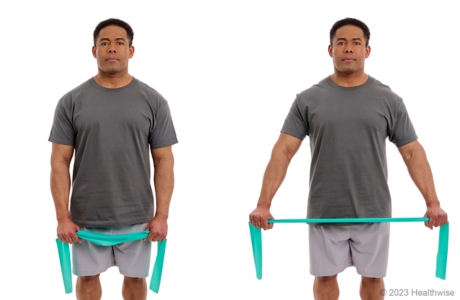
- Stand or sit up straight in a chair without arms. Grasp an exercise band with your hands about shoulder-width apart.
- Hold your hands at the level of your hips, or near your lap if you are sitting down.
- Slowly pull your hands apart, stretching the band. Hold for 1 or 2 seconds.
- Slowly return to your starting position.
- Repeat 8 to 12 times.
Weight training with free weights
Chest fly (lying down)
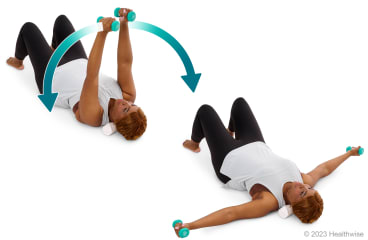
- Lie on a bench or exercise ball, and hold light weights straight up over your chest. You can also use soup cans or filled water bottles for weights. Do not lock your elbows. You can keep them slightly bent if that is more comfortable.
- Slowly lower your arms, keeping them extended, until the weights are level with your chest or slightly lower.
- Slowly raise your arms until you are in the starting position.
- Repeat 8 to 12 times.
Arm raise to the side (elbows bent)
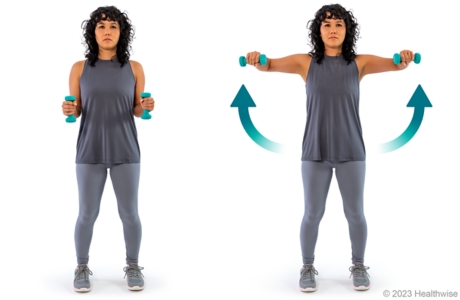
- Stand with your feet shoulder-width apart and your knees slightly bent. Or sit up straight in a chair.
- Hold a 1- to 2-pound weight in each hand. The weight may be a dumbbell, a can of food, or a filled water bottle.
- Bend your elbows 90 degrees while keeping them at your sides. With your palms facing in, hold the weights straight in front of you.
- Slowly lift the weights and your elbows out to the sides to shoulder level, keeping your elbows bent. Keep your shoulders down and relaxed as you lift. If you find that you are shrugging your shoulders up toward your ears, your weights may be too heavy. Try using lighter weights (or even no weights).
- Slowly lower the weights and your elbows until your elbows are back at your sides.
- Repeat 8 to 12 times.
Biceps curl
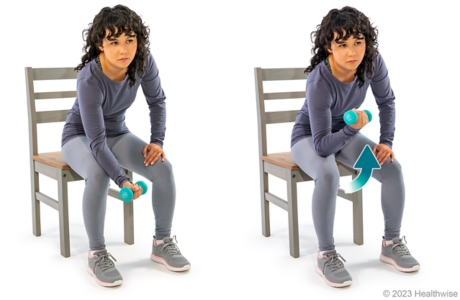
- Sit leaning forward with your legs slightly spread apart and your left hand on your left thigh.
- Hold a 1- to 2-pound weight in your right hand. The weight may be a dumbbell, a can of food, or a filled water bottle.
- Place your right elbow on your right thigh, keeping your elbow slightly bent.
- Slowly lift (curl) the weight up and toward your chest.
- Slowly return it to the starting point.
- Repeat 8 to 12 times.
- Repeat these steps with your other arm.
Related Information
References
Citations
Credits
Current as of: July 31, 2024
Author: Ignite Healthwise, LLC Staff
Clinical Review Board
All Healthwise education is reviewed by a team that includes physicians, nurses, advanced practitioners, registered dieticians, and other healthcare professionals.
Current as of: July 31, 2024
Author: Ignite Healthwise, LLC Staff
Clinical Review Board
All Healthwise education is reviewed by a team that includes physicians, nurses, advanced practitioners, registered dieticians, and other healthcare professionals.

